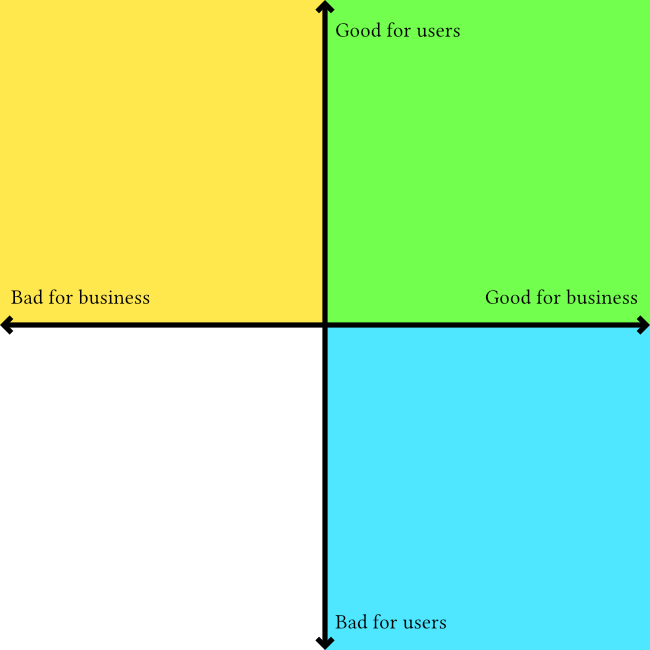Feedback types: Is this a thing? / challenging perspectives / general opinions
Here’s an outline which I originally posted as a tweet thread but would like to flesh out into a fill article with images like the attached one to illustrate the “zones” that people may/may not realise they are acting in when they say stuff like “what’s good for the user is good for the business”
I am writing this because I’ve published a few things now which say that empathy and “human centeredness” in commercial design, particularly UX design/research, are theatrical and not compatible with capitalism if done deliberately. That means they can be true as a side-effect, or by individuals acting under the radar of their employers. It has become common to hear the good for the user = good for the business response - and I want to write something that demonstrates how it is an incomplete sentence, and any way to add the necessary information to make it true results in the speaker admitting they are not acting in the interests of users or humans.
Here’s the basic outline so far:
What’s good for the User
“What’s good for the user is good for the business” is a common response I get to my UX critique. When I try to understand the thinking behind that response I come up with two possible conclusions:
Conclusion 1: They are ignoring the underlying product and speaking exclusively about the things between the product and a person. They are saying that making anything easy to use, intuitive, pleasant, makes a happy user and a happy user is good for business.
This type of “good for the user” is a business interest that values engagement over ethics. It justifies one-click purchases of crypto shitcoins, free drinks at a casino, and self-lighting cigarettes. https://patents.google.com/patent/US1327139
Conclusion 2: They are speaking exclusively about the underlying product and the purposes it was created to serve. They say a good product will benefit the business. But this means they are making a judgement call on what makes a product “good”.
This type of “good for the user” is complicated because it is a combination of objective and subjective consideration of each product individually. It is design in its least reductive form because the creation of something good is the same with or without business interests. A designer shouldn’t use blanket statements agnostic to the design subject. “what is good for the user…” ignores cigarette packet health warnings and poker machine helpline stickers there because of enforced regulation, not because of a business paying designers to create them.
It’s about being aware of the context, intent, and whose interests are being served. It means cutting implied empathy for people if it is bullshit.
If we look at this cartesian plane diagram we can see the blue and green quadrants that corporate product design operates in. The green being where the “good for user, good for business” idea exists, and the yellow representing the area that the idea ignores, dismisses, etc



I like this understanding of SaaS more than the one I’ve internalized: that it’s a return to the mainframe days. that’s a useful model from an engineering perspective (compare the UI cues and design priorities of an IBM x/system and a large cloud provider’s admin dashboards, especially around how billing and compute are treated) but yours is a better model for understanding how these systems work sociologically
weirdly, the example of applications becoming amorphous services without a clear purpose that came to mind for me was (and I hate this term but it’s the one in use) AAA gaming. there was a big push towards making games into live services which are amorphous blobs of dynamic content that can’t truly be bought. alongside the reasons you gave, one reason that corporations love to push this model for AAA games is that (in spite of promises to the contrary), live services have a defined and usually extremely short shelf life, and after that it becomes impossible to play the game in any form. this isn’t compatible with how I engage with video games, so it was a big part of why I switched almost entirely to playing indie games, where this model is unheard of
Oh I’m so glad you brought up games. They are so interesting because they are “games” before they are “software” - regardless of them being digital or physical products, commercial or social, whatever, they have a purpose of entertainment built in. If they aren’t entertaining, they suck. That’s the invisible barrier that crypto people ignore, think doesn’t exist, or are too dumb to understand. We never called games “applications” because their application is consistent no matter what genre of game they are.
I’ve thought about a link between games and spreadsheets in this sense. They are both things that computation, as a means for satisfying their purpose, is undeniably perfect for.
Games are one of the few consumer-grade software products that give a tangible reason for buying a faster, more powerful, computer.
But we have to upgrade because the operating systems get bloated and the web is putting more and more load on our machines for very little pay off.
ugh
yeah, games-as-service is a fantastic example of one of the cases I reference in my other comment
it becomes so easy for games companies to just shift to lootboxes and apparel as their “delivering value” path, and beyond social outroar there’s essentially no counterpressure available in-system to modulate that happening (and even in the social outroar case there’s no guarantee it’ll work)